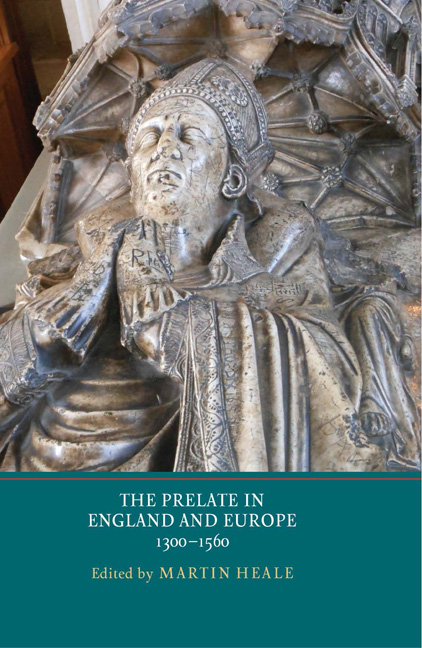56 results
Implementing strategies to prevent infections in acute-care settings
- Part of
-
- Journal:
- Infection Control & Hospital Epidemiology / Volume 44 / Issue 8 / August 2023
- Published online by Cambridge University Press:
- 11 July 2023, pp. 1232-1246
- Print publication:
- August 2023
-
- Article
-
- You have access
- Open access
- HTML
- Export citation
4 - Earlier Version/Later Version – in the Wycliffite Bible Is that the Only Choice?
-
-
- Book:
- Medieval and Early Modern Religious Cultures
- Published by:
- Boydell & Brewer
- Published online:
- 02 June 2021
- Print publication:
- 17 May 2019, pp 63-82
-
- Chapter
- Export citation
Contributors
-
-
- Book:
- The Cambridge Dictionary of Philosophy
- Published online:
- 05 August 2015
- Print publication:
- 27 April 2015, pp ix-xxx
-
- Chapter
- Export citation
Part III - Identity and Display
-
- Book:
- The Prelate in England and Europe, 1300–1560
- Published by:
- Boydell & Brewer
- Published online:
- 05 November 2014
- Print publication:
- 20 November 2014, pp 171-172
-
- Chapter
- Export citation
List of Illustrations
-
- Book:
- The Prelate in England and Europe, 1300–1560
- Published by:
- Boydell & Brewer
- Published online:
- 05 November 2014
- Print publication:
- 20 November 2014, pp vii-ix
-
- Chapter
- Export citation
Introduction
-
- Book:
- The Prelate in England and Europe, 1300–1560
- Published by:
- Boydell & Brewer
- Published online:
- 05 November 2014
- Print publication:
- 20 November 2014, pp 1-14
-
- Chapter
- Export citation
Lollard Views on Prelates
- from Part IV - Attitudes towards Prelacy
-
-
- Book:
- The Prelate in England and Europe, 1300–1560
- Published by:
- Boydell & Brewer
- Published online:
- 05 November 2014
- Print publication:
- 20 November 2014, pp 277-294
-
- Chapter
- Export citation
List of Abbreviations
-
- Book:
- The Prelate in England and Europe, 1300–1560
- Published by:
- Boydell & Brewer
- Published online:
- 05 November 2014
- Print publication:
- 20 November 2014, pp xii-xiv
-
- Chapter
- Export citation
List of Contributors
-
- Book:
- The Prelate in England and Europe, 1300–1560
- Published by:
- Boydell & Brewer
- Published online:
- 05 November 2014
- Print publication:
- 20 November 2014, pp x-x
-
- Chapter
- Export citation
Index of Subjects
-
- Book:
- The Prelate in England and Europe, 1300–1560
- Published by:
- Boydell & Brewer
- Published online:
- 05 November 2014
- Print publication:
- 20 November 2014, pp 314-317
-
- Chapter
- Export citation
YORK MEDIEVAL PRESS: PUBLICATIONS
-
- Book:
- The Prelate in England and Europe, 1300–1560
- Published by:
- Boydell & Brewer
- Published online:
- 05 November 2014
- Print publication:
- 20 November 2014, pp 318-321
-
- Chapter
- Export citation
Preface and Acknowledgements
-
- Book:
- The Prelate in England and Europe, 1300–1560
- Published by:
- Boydell & Brewer
- Published online:
- 05 November 2014
- Print publication:
- 20 November 2014, pp xi-xi
-
- Chapter
- Export citation
Part IV - Attitudes towards Prelacy
-
- Book:
- The Prelate in England and Europe, 1300–1560
- Published by:
- Boydell & Brewer
- Published online:
- 05 November 2014
- Print publication:
- 20 November 2014, pp 259-260
-
- Chapter
- Export citation
Part II - Patronage and Learning
-
- Book:
- The Prelate in England and Europe, 1300–1560
- Published by:
- Boydell & Brewer
- Published online:
- 05 November 2014
- Print publication:
- 20 November 2014, pp 99-100
-
- Chapter
- Export citation
Index of People and Places
-
- Book:
- The Prelate in England and Europe, 1300–1560
- Published by:
- Boydell & Brewer
- Published online:
- 05 November 2014
- Print publication:
- 20 November 2014, pp 295-313
-
- Chapter
- Export citation
Frontmatter
-
- Book:
- The Prelate in England and Europe, 1300–1560
- Published by:
- Boydell & Brewer
- Published online:
- 05 November 2014
- Print publication:
- 20 November 2014, pp i-iv
-
- Chapter
- Export citation
CONTENTS
-
- Book:
- The Prelate in England and Europe, 1300–1560
- Published by:
- Boydell & Brewer
- Published online:
- 05 November 2014
- Print publication:
- 20 November 2014, pp v-vi
-
- Chapter
- Export citation
Part I - Prelates and Power
-
- Book:
- The Prelate in England and Europe, 1300–1560
- Published by:
- Boydell & Brewer
- Published online:
- 05 November 2014
- Print publication:
- 20 November 2014, pp 15-16
-
- Chapter
- Export citation

The Prelate in England and Europe, 1300–1560
-
- Published by:
- Boydell & Brewer
- Published online:
- 05 November 2014
- Print publication:
- 20 November 2014
Genetic and Environmental Risk for Major Depression in African-American and European-American Women
-
- Journal:
- Twin Research and Human Genetics / Volume 17 / Issue 4 / August 2014
- Published online by Cambridge University Press:
- 09 June 2014, pp. 244-253
-
- Article
-
- You have access
- HTML
- Export citation



